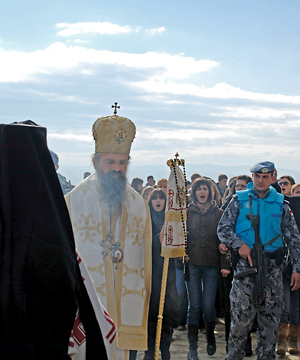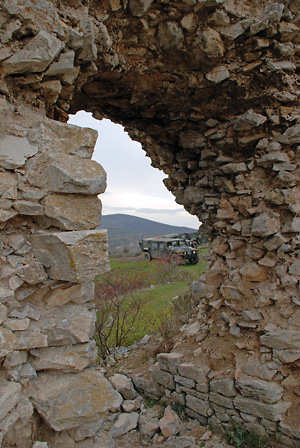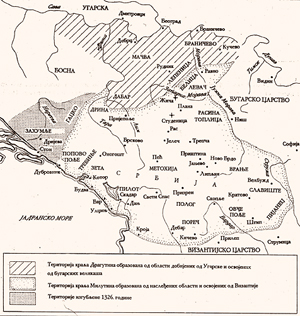The Heart of Serbia
THE EPISCOPE OF LIPLJAN AND PRIOR OF DEČANI TEODOSIJE, IN AN EXCLUSIVE AUTHORIAL TEXT FOR THE ”NATIONAL REVIEW”, ABOUT THE ATTEMPTS OF ALBANIZATION OF SERBIAN HERITAGE IN KOSOVO AND METOHIJA
Defend the Truth and Identity
Quasi-historical claims, serving as basis for the systematic attempts to rename the Serbian heritage in Kosovo and Metohija into Albanian, are so preposterous and vulgar that unmasking them is needless. However, it is very important to engage all Serbian spiritual and intellectual forces to present the Serbian cultural heritage correctly in the insufficiently informed world. The state of Serbia, through UNESCO and other international organizations, regardless of the status of the province and international reactions to that status, has the obligation to ensure an appropriate institutional and safety protection of the Serbian heritage in that area from further destructions and changes of identity
 In the process of creating a new Albanian artificial state in the space of the Serbian Province Kosovo and Metohija, for dozens of years a significant number of Albanian historians and journalists have been working on forging the history of this area and complete negation of the Serbian share in the spirituality and culture of the southern Serbian Province. After the unfortunate events in 1999, under the excuse of an alleged revenge to the Serbs, during the previous 8 years, the Albanian extremists destroyed or severely damaged 150 Serbian Orthodox edifices, some of them of invaluable international significance. Since the Serbian Orthodox Church had a very moderate political stand both during the war and after it, and since it was against any kind of violence, regardless of what side it came from, it is completely clear that the main cause of this systematic destruction of Serbian heritage was related to the already existing tendencies of erasing Serbian spiritual and cultural traces and wiping out the Serbian people from the space where it left internationally recognized cultural and historical monuments to the European civilization. This process actively began already after World War II, by creating the Autonomous Province of Kosovo, when the secession ideas intensified. In the process of creating a new Albanian artificial state in the space of the Serbian Province Kosovo and Metohija, for dozens of years a significant number of Albanian historians and journalists have been working on forging the history of this area and complete negation of the Serbian share in the spirituality and culture of the southern Serbian Province. After the unfortunate events in 1999, under the excuse of an alleged revenge to the Serbs, during the previous 8 years, the Albanian extremists destroyed or severely damaged 150 Serbian Orthodox edifices, some of them of invaluable international significance. Since the Serbian Orthodox Church had a very moderate political stand both during the war and after it, and since it was against any kind of violence, regardless of what side it came from, it is completely clear that the main cause of this systematic destruction of Serbian heritage was related to the already existing tendencies of erasing Serbian spiritual and cultural traces and wiping out the Serbian people from the space where it left internationally recognized cultural and historical monuments to the European civilization. This process actively began already after World War II, by creating the Autonomous Province of Kosovo, when the secession ideas intensified.
In the aggressive ”nation building” process of the Kosovo Albanians, and with the support of quasi-historians from Tirana who dream about the establishing of a country of all Albanians, which never existed in history, under the international administration of the UN, toponyms are systematically changed. The Serbian Orthodox churches are represented as ”Albanian”, even ”Illyrian”, and the Serbs are reduced to a minority which historically arrived to the Albanian ethnic space (the Albanians see themselves as direct successors of the Illyrians) only to destroy and plunder an already existing civilization. The architecture of the Nemanjić family is named Albanian-Illyrian, although such a term doesn’t exist in art history. Even though there is not a single serious historian able to support these fictive claims with any valid argument, they are today regularly served to foreigners, to the Kosovo youth, to tourist agencies.
THE GREEK LESSON  It is completely unacceptable for the creators of the new Albanian Kosovo, in which the Serbs, if they would be able to survive in it at all, should become a completely marginalized community, to have the most significant monuments of culture and spirituality belonging to the Serbian Orthodox Church and the Serbian nation. Hence the attempts to rename overnight what wasn’t already destroyed in the attacks of vandalism, and turn it into ”Roman Catholic Albanian churches”. The Serbs, as the Priština historians claim, turned those churches during the reign of emperor Dušan into Orthodox churches and suffocated the ”thousand years” of culture of the Albanians-Illyrians, who now present themselves as one of the oldest Christian European nations. It is completely unacceptable for the creators of the new Albanian Kosovo, in which the Serbs, if they would be able to survive in it at all, should become a completely marginalized community, to have the most significant monuments of culture and spirituality belonging to the Serbian Orthodox Church and the Serbian nation. Hence the attempts to rename overnight what wasn’t already destroyed in the attacks of vandalism, and turn it into ”Roman Catholic Albanian churches”. The Serbs, as the Priština historians claim, turned those churches during the reign of emperor Dušan into Orthodox churches and suffocated the ”thousand years” of culture of the Albanians-Illyrians, who now present themselves as one of the oldest Christian European nations.
It is truly needless to unmask the preposterousness of such quasi-historical claims. It is very important to engage all Serbian spiritual and intellectual potentials to adequately present the Serbian cultural heritage to the world, and to unmask the destructive effect of the Kosovarization of Serbian heritage promoters. When the polemics between Athens and Skopje regarding the name Macedonia, which geographically and historically has a much wider meaning that the former Yugoslav republic with this name, reached its peak, all Greek diplomatic representations, tourist agencies, border crossings had large posters pointing out the significance of Hellenist Macedonia for the Greek history and culture. Therefore, it is very important to, in a similar way, scientifically, historically documented, in written and electronic form, present the Serbian heritage to the world in the most adequate manner, especially considering the fact that it was de facto acknowledged during the negotiations in Vienna last year. Then the Kosovo government, at least formally, took the obligation to respect the identity and property of the Serbian Orthodox Church in Kosovo and Metohija.
THE DUTIES OF THE SERBIAN STATE  The Serbian spiritual and cultural heritage in Kosovo and Metohija, of course, represents a part of the general European cultural significance, and as such, it is important not only for the Serbs and Kosovo Albanians, but for the whole mankind. However, if Kosovo sets off down the road of unilaterally proclaiming a quasi-state within Serbia, it is absolutely unacceptable to have this serve as a motif to completely wipe out the Serbian spiritual and historical existence in this area. The Serbian state, through UNESCO, international organizations and forums, regardless of the status of the province and international reactions to that status, has the obligation to ensure an appropriate institutional and safety protection of the Serbian heritage in that area from further destructions and changes of identity. The Serbian spiritual and cultural heritage in Kosovo and Metohija, of course, represents a part of the general European cultural significance, and as such, it is important not only for the Serbs and Kosovo Albanians, but for the whole mankind. However, if Kosovo sets off down the road of unilaterally proclaiming a quasi-state within Serbia, it is absolutely unacceptable to have this serve as a motif to completely wipe out the Serbian spiritual and historical existence in this area. The Serbian state, through UNESCO, international organizations and forums, regardless of the status of the province and international reactions to that status, has the obligation to ensure an appropriate institutional and safety protection of the Serbian heritage in that area from further destructions and changes of identity.
In this process and in our time, the Serbian Orthodox Church has a special role. As an everlasting guardian of Serbian sanctities, even in Old Serbia, the Church has always been one of the most important elements in maintaining the identity of this, for many reasons, most important part of the Serbian spiritual and national being.
***
Roman-Byzantine-Gothic-Albanian Style
The official web portal of the Kosovo Ministry of Trade and Industry (Department of Tourism), www.visitkosova.org, on a page with the picture of the Gračanica monastery from the XIV century, endowment of the Serbian king Milutin Nemanjić, includes this text (in English, Shqip and Serbian):
”The rich treasury of works created by Albanian architects and artists also include architectural edifices. (…) Also belonging to these Kosovo landmarks are certain sacral Paleochristian objects, i.e. churches, which were built and used for liturgies and religious ceremonies of the Illyrian-Albanian population ever since the IV century. These objects were destroyed by many barbaric invasions and conquerors. The ruins of many of these objects can be found in different parts of Kosovo. Furthermore, a certain number of monumental edifices, such as monasteries, Albanian-Byzantine style churches, eclectic Roman-Byzantine-Gothic-Albanian style churches, built during the XIV century, on the foundations of the Paleochristian objects, managed to resist the ravages of time. Some monumental architectural objects of the Orthodox faith from this century are especially worthy, not only for the cultural heritage of the Kosovo people, but because they are of universal value.”
|
